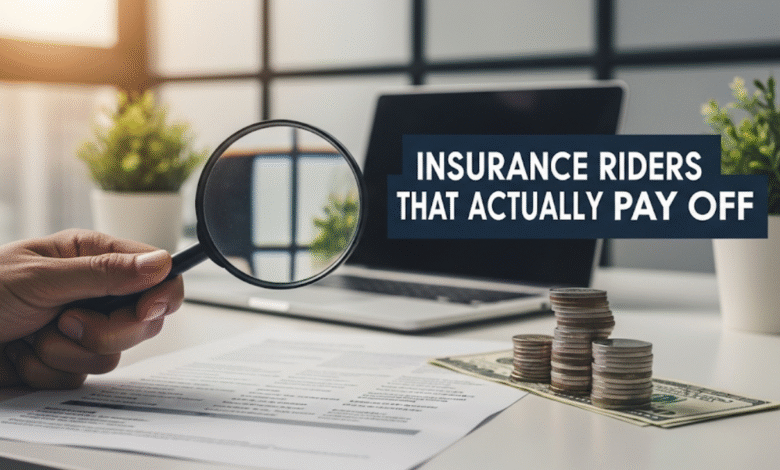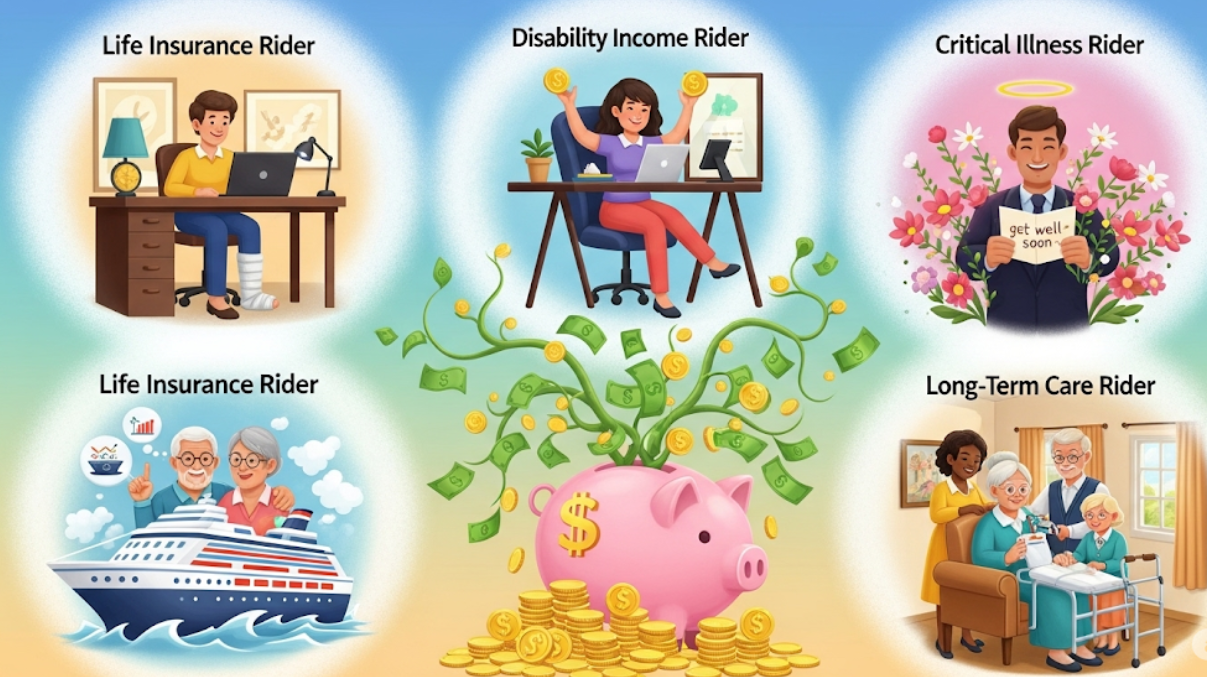
“Riders” is a term you will hear a lot when shopping for insurance — those supplementary add-ons promising extra coverage for a small added fee. But here’s the million-dollar question: which of them are worth your money? Having looked at thousands of insurance claims and talked to industry experts, we’ve singled out the riders that can make a difference when you need them most.
Consider insurance riders the options package for a new car. Some of them are glitzy but worthless; some could save your life — or at least save you some money. In this guide, we’ll cut through the sales pitch and tell you exactly which riders pay off and which ones you should pass on.
What’s It Worth to You to Add a Rider to Your Insurance?
Before we get into individual riders, let’s talk about what makes any insurance option worth adding. A good rider should have the following:
Frequency: It can cover cases which do, in fact, happen to real people.
Financial impact: Rider’s cost small, potential loss is great
Coverage gaps: It covers gaps in your base policy that may leave you vulnerable
Savings vs Cost: The cost of the premium is reasonable compared to potential savings
Next, let’s look at riders that consistently offer value irrespective of the kind of insurance.
Life Insurance Riders That Make Sense
Waiver of Premium Rider: Your Safety Net In Times of Adversity
This rider could be the most unsung gem in life insurance. If you become disabled or otherwise unable to work, the waiver of premium rider helps ensure your life insurance policy stays in place without your having to pay premiums.
Why it pays off: Disability is far more frequent than death would be for working-age adults. A 20-year-old employee, the Social Security Administration reports, has a one-in-four chance of becoming disabled before reaching retirement. Without the rider, the very time when your family needs protection — the moment you die prematurely — is exactly when you may have to let the policy lapse.
Real-life example: Sarah, a 35-year-old teacher, was paralyzed in a car wreck. For the two years she couldn’t work, her $15-a-month waiver of premium rider kept her family’s $500,000 life insurance policy from lapsing.
Cost: Usually 5-15% of your base premium
Best for: Breadwinner with dependents
Accelerated Death Benefit Rider: Get Your Death Benefit When You Need It Most
Another option is a rider that allows you to access a portion of your death benefit should you be diagnosed with a terminal illness, which generally means you have 12 to 24 months to live.
Why it pays off: Last illnesses are costly. Treatment for cancer alone could run up to $150,000. This rider provides you with access to funds to pay for experimental treatments, travel for care or simply maintain your quality of life.
The catch: Money you take out diminishes what your heirs receive, but for many that’s a trade-off worth making.
Price: Often comes for free or for a small fee
Best for: People who are worried about the cost of end-of-life medical care
Auto Riders You Won’t Mind Paying Extra For
Gap Insurance Can Be a New Car Owner’s Best Friend
If you borrow or lease a car, gap insurance reimburses the difference between how much you owe and how much the car is worth if it’s totaled.
Why it works: New cars lose 20% of their value when you drive them off the lot. If you total your car in the first few years, standard insurance only pays the current market value – which can be thousands less than what you owe.
Example:
| Scenario | Loan Balance | Car Value | Your Responsibility | With Gap Insurance |
|---|---|---|---|---|
| Year 1 Total Loss | $25,000 | $20,000 | $5,000 out of pocket | $0 |
| Year 2 Total Loss | $22,000 | $18,000 | $4,000 out of pocket | $0 |
Cost: $20 to $40/year when you add to your car policy
Best for: Anyone who financed more than 80% of their car value
Rental Car Coverage: It’s Cheap and Easy to Get
This pays rental car expenses for a replacement vehicle if your car is disabled following an accident in which a claim is made under this coverage.
Why it works: Car repairs can drag on for weeks, particularly following accidents. Those $30-60 daily rental rates add up fast. When you need it, it can save you hundreds for an annual price of $30-40 per rider.
Pro tip: Opt for the coverage you need. If you can arrange for other transportation, basic is perfectly adequate. If you depend heavily on your car, choose higher daily limits.
Home Insurance Riders That Protect Your Biggest Investment
Scheduled Personal Property Coverage: For Your Precious Things
Homeowner’s insurance has limits on high value items such as jewelry, art, or electronics. This add-on gives you specialized coverage for expensive items.
Why it’s worth it: Your $5,000 engagement ring may only be insured for $1,500 under a standard policy’s jewelry limit. Scheduled coverage includes maximum value, typically mysterious disappearance, etc.
Coverage includes:
- Accidental damage
- Theft (even outside your home)
- Mysterious disappearance
- Full replacement cost
Cost: Typically 1-3% of the value of the item per year
Best for: People who own jewelry, art, collectibles or expensive electronics valued at more than $2,500
Water Backup Coverage: The Hidden Threat to Your Home
Most standard homeowners insurance does not cover damage from water backing up through drains or sewers. This rider fills that gap.
Why it pays off: Clogs are unsanitary, can flood a basement in short order and are serious business even in the lowest parts of the house, where extra feet of sewage and water won’t be appreciated. Sewer backups happen more often than you might think, especially in older areas or when it starts to pour. Restoration and cleanup efforts can often run upwards of $10,000-20,000.
What it covers:
- Sump pump failures
- Sewer line backups
- Drain overflows
- Water spoilage of contents and structure
Cost: $40 to $250 per year (varies based on coverage limits)
Best for: Homes with basements, older plumbing, or located in flood-prone areas
Building Code Upgrade Coverage: When Standards Change
This code upgrade insurance, also known as building ordinance insurance, covers the cost of bringing the building up to code as it is rebuilt (or the undamaged portion of the building).
When rebuilding after a total loss, you have to build in accordance with the current building codes — and there’s a good chance that those will be tougher than the codes in place when your home was originally built.
Why it pays: Building code upgrades can cost 20 percent to 50 percent more than reconstruction. Without this protection, you’re on the hook for those additional costs.
Real example: Tom’s home from the 1970s burned down. Reconstruction also brought the need for updated electrical and plumbing and new standards of insulation, at an additional cost of $75,000. His ordinance coverage covered the bill.
Cost: 5-10% more premium
Best for: An older home or a strict building code area
Gap-Filling Health Insurance Riders
Critical Illness Coverage: The Financial Lifeline
This rider will pay you a lump sum upon diagnosis of certain specified critical illnesses such as cancer, heart attack or stroke.
Why it pays: Critical conditions, even with health insurance, can have hidden costs:
- Lost income during treatment
- Cancer treatments that are not covered by insurance
- Travel costs for specialized care
- Home modifications for recovery
Average payout: $10,000 to $100,000 (depending on the coverage you choose)
Cost: $15-50 per month for $25,000 of coverage
Best for: Main breadwinners, or if you have family history of a critical illness
Hospital Indemnity: Cash When You’re Laid Up
Pays a daily amount for each day during which you are hospitalized, regardless of your medical costs.
Why it pays off: Hospital stays are costly and disruptive. This coverage helps with:
- Deductibles and copays
- Lost wages
- Childcare costs
- Transportation for family visits
Average benefit: $100-500 per day
Cost: $8-25 per month
Best for: Individuals with high-deductible health plans; those with inconsistent income

Riders to Avoid: The Money Drains
All riders aren’t created equal. Here are a few that hardly ever work:
Mortgage Protection Life Insurance
Why to avoid: Typically overpriced compared to traditional term life insurance. Your family may not want a simple payoff of the mortgage but take cash instead.
Cancer-Only Policies
Why you can skip: Too narrow in focus. Critical illness insurance provides more comprehensive benefits and is generally cheaper.
Accidental Death Benefit on Life Insurance
Why to avoid: Death is death — your loved ones can use the money no matter where it comes from. Term life insurance is better.
Smart Shopping: Picking the Perfect Riders
Calculate the Value Proposition
For each rider you’re considering:
- Estimate how likely you are going to require it
- Determine what you would have to pay if you don’t have coverage
- Compare the annual cost to the rider
- Take into account your financial cushion — can you do without the money?
Ask the Right Questions
Before adding any rider:
- What does this even cover that isn’t already covered in my base policy?
- What are the inclusions & exclusions?
- What would this amount to over the life of my policy?
- Can I find better coverage elsewhere for less?
Review Regularly
Your life will change, and so your insurance will need to change with it. Review your riders annually:
- When you pay off the car loan? (Drop gap coverage)
- Did the jewelry go up in value? (Increase scheduled coverage)
- Did you marry or have kids? (Consider additional riders)
Bottom Line: Think Smart as a Rider
The best insurance riders have one thing in common: They protect you from financial catastrophes that are both potentially devastating and costly. Concentrate on riders that protect against common risks that have a high financial impact, and skip the ones that sound scary but are extremely rare.
Pick riders that work for your wallet, not ones that make you feel like you’ve accounted for every remote possibility.
Through careful selection of the riders you add, you can create far-reaching protection without spending a fortune. The question is being aware of what you are actually getting and whether it is worth the amount of money for your particular needs.
First, figure out the areas in which you are most financially vulnerable and focus there. Find riders that answer those gaps. Your future self will thank your present self for making these smart choices.
Frequently Asked Questions
What is the difference between an insurance rider and an endorsement?
For the most part, these terms are used interchangeably. Both are changes you can make to your base insurance policy that will add, change or remove coverage. (The term “rider” is used by some companies for life insurance add-ons and “endorsement” is used in property insurance for modifications.)
Can I add riders to my current policy?
Yes, with most, you can add riders at any time during your policy year (although some may require underwriting). You should contact your insurance agent and consider adding riders to your existing coverage.
Do riders increase my deductible?
It all depends on the rider and the insurance company. Some riders have their own deductibles, while others are designed to mimic the deductible structure of your base policy. Be sure to inquire about deductible consequences before adding coverage.
Typically, how much do riders cost for insurance?
Rider fees can be much more or much less expensive depending on the kind of coverage and how much risk you pose. Basic riders might cost subscribers $20-50 a year, while all the bells and whistles could cost a few hundred dollars a year. Always weigh the cost relative to potential savings.
Am I allowed to cancel riders if I no longer need them?
Most riders can be deleted from your policy at renewal, and some can be canceled mid-term. But if you remove and then add back certain riders (particularly life insurance riders), you might have to jump through new underwriting hoops, so be sure you do your homework before you cancel.
Are riders tax-deductible?
In general, insurance riders adhere to the same tax rules as your base policy. Riders that are business related may be deductible as business expenses, though personal insurance riders are usually not tax-deductible. Discuss your individual circumstance with a tax expert.
Where do my riders go if I switch insurance companies?
Riders don’t automatically move to new insurers. When changing companies, you must re-purchase riders with your new policy. This is why it’s so crucial to be mindful of total coverage cost, including riders, when comparing insurance quotes.
How can I tell if a rider claim has been handled properly?
Maintain good records of all contact you have with the insurance company. If you think a rider claim was wrongfully denied, check your policy language and perhaps consider hiring a public adjuster or attorney if lots of money is at stake.

